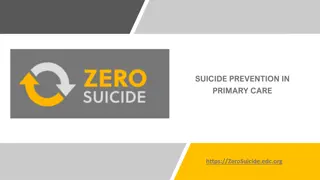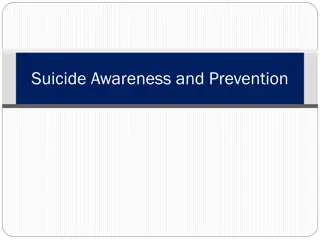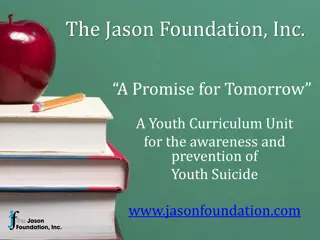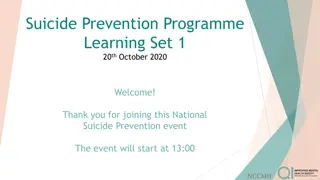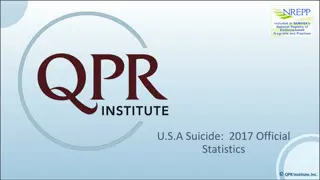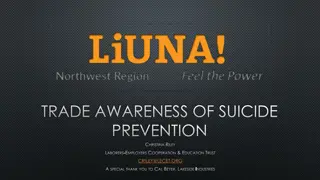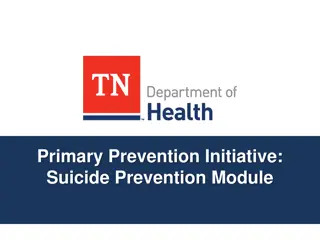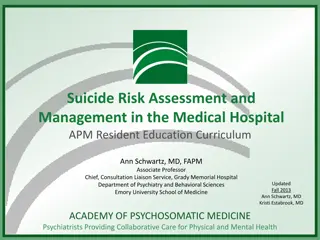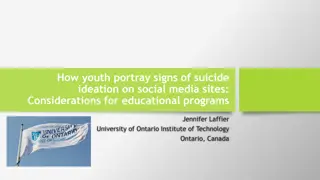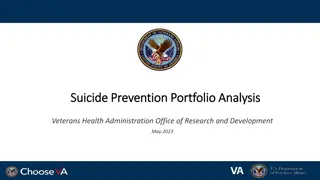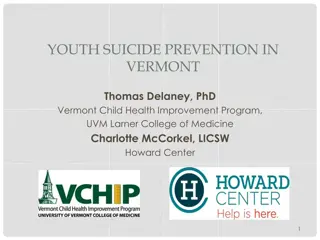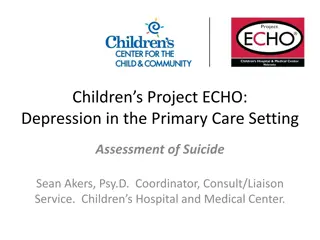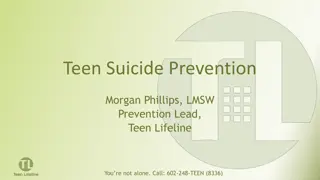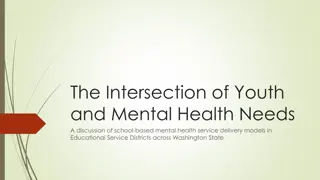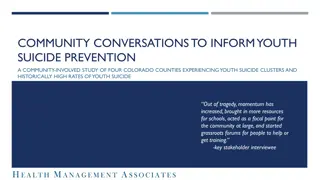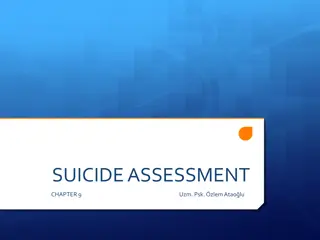A Promise for Tomorrow: Youth Suicide Awareness and Prevention Curriculum
Explore a youth curriculum unit addressing youth suicide awareness and prevention in the United States, initiated by The Jason Foundation, Inc. Discover statistics, facts, and resources to equip yourself in helping friends going through depression or contemplating suicide. Take a pledge to support and be there for those in need.
Download Presentation

Please find below an Image/Link to download the presentation.
The content on the website is provided AS IS for your information and personal use only. It may not be sold, licensed, or shared on other websites without obtaining consent from the author.If you encounter any issues during the download, it is possible that the publisher has removed the file from their server.
You are allowed to download the files provided on this website for personal or commercial use, subject to the condition that they are used lawfully. All files are the property of their respective owners.
The content on the website is provided AS IS for your information and personal use only. It may not be sold, licensed, or shared on other websites without obtaining consent from the author.
E N D
Presentation Transcript
The Jason Foundation, Inc. A Promise for Tomorrow A Youth Curriculum Unit for the awareness and prevention of Youth Suicide www.jasonfoundation.com
A Promise for Tomorrow Lesson A This lesson will introduce the problem of youth suicide in the United States and provide statistics to enhance awareness about the magnitude of this silent epidemic.
A Promise for Tomorrow Sometimes we must study some tough subjects in our class in order to prepare you to help yourself and your friends for life s challenges. Today we are going to begin to look at one such subject.
A Promise for Tomorrow In 1999, U.S. Surgeon General, Dr. David Satcher, declared suicide as a National Health Problem especially within the youth and elderly populations. Due to this, the Surgeon General released the National Strategy for Suicide Prevention.
A Promise for Tomorrow Today in our school, we begin to answer this Call to Action by equipping ourselves with the information and resources needed to help a friend who may be depressed, having trouble in relationships, or may be considering suicide. Suicide has been labeled the number one preventable cause of death in our nation today. It is preventable because, for those individuals who need it, there is help available that can make a positive difference in their lives.
A Promise for Tomorrow First, I want you to learn about the current statistics and some common myths that surround the topic of suicide. Next, you will learn about some behaviors that are often shown by a young person who is depressed or thinking about suicide. Third, you will learn some ways you can help a friend who may be depressed or considering suicide. And last, we will explore some resources that you could turn to if a friend needs help. You will have an opportunity to take a pledge to be there for your friends and to design a plan of action to help your friends if the need arises.
A Promise for Tomorrow Jason s Story
A Promise for Tomorrow These lessons were designed by The Jason Foundation, Inc. You have probably already determined that this foundation is named for someone. It is named for a young man who died by suicide in 1997. His name was Jason and he was a typical teenager. Jason played football, made B s in school and lived with his mom, dad and older brother. He and his family went to church together and got along well with each other. Jason had many friends and was popular in school. He didn t drink alcohol or abuse drugs. Jason was sixteen and had just gotten his driver s license. He had even been given a used car to drive. One would think that he had a great life and he did. But, something was terribly wrong. For some reason, Jason made a decision that changed the lives of everyone around him. His decision eliminated the chance for him to find another solution to his pain and unhappiness. Jason took his own life on July 16, 1997. If only he had shared with someone how he felt, he could have gotten help and most likely would still be here today.
A Promise for Tomorrow After Jason died, his family started to learn about youth suicide. They learned many things that they now want to share with you. The main thing they learned is that when a young person is thinking about suicide there are almost always warning signs in their words and/or behavior. When they learned some of these signs they thought back about Jason. He had shown several of those signs before he died. If his family and friends had been educated to recognize the warning signs, they would have realized how troubled Jason was and could have gotten help for him.
A Promise for Tomorrow What we want to accomplish here is to provide you with the information to recognize any of these signs so that if you ever have a friend who is thinking of suicide, you will know what to do to help. The one thing you need to always remember is that time changes circumstances. Time will solve most all of our personal problems. Jason did not give himself any time to feel better or solve any of his problems. Problems are temporary; suicide is permanent. We must learn to help our friends find other solutions to their problems and help them understand that time can change things, if we just hold on and persevere.
Teen Suicide You need to understand that most young people never attempt suicide and weather the storms of adolescence with no major problems. However, entirely too many young people have extreme difficulties and develop severe depression which can lead to suicidal thoughts. Most teens who have attempted suicide say that they did not want to die. They wanted the pain to go away. We want to be able to identify our friends who are in pain and know what to do to help.
A Promise for Tomorrow Let s see what you already know about the problem of Youth Suicide.
Questions True or False
Question 1 Suicide is the SECOND leading cause of death among young people between the ages of 10 and 24.
Answer TRUE The 1st leading cause is accidents of all kinds.
In the United States How many young people do we lose, each year, to suicide?
Deaths by Suicide It is estimated we will lose approximately 5,000 young people to suicide each year.
Deaths Each week Let us think about this in another way. We lose approximately 130 young people to suicide each week in this country. If there were a virus sweeping the country causing these deaths, would we hear about it anywhere? Of course, it would be on the news COVID is all over the news. Your family would be worried and contacting your doctor and taking precautions, right? The problem with the silent epidemic of suicide is that we are losing about 130 young people each week but no one is willing to talk about it. We do not need to hear about each individual suicide; however, we do need to know that this problem exists.
Question 2 People who talk about or threaten suicide rarely die by suicide.
Answer FALSE Many times people who are thinking about suicide make statements or threats about it. They may make statements like, I d be better off if I weren t even here , or, I won t be bothering you much longer. People who talk about suicide are thinking about it and should be taken seriously. Even if they are not suicidal, it is obvious that they are not happy. We need to ask questions and find out what is so wrong in their lives. They are desperately asking for help. We want to be able to provide that help.
Question 3 Approximately one young person dies by suicide every 2 hours.
Answer TRUE Consider this: From the time you get up in the morning until school begins, one young person in the United States has died by suicide. During the time it takes for you to enjoy a movie or a basketball game, another young person has died because of suicide.
Question 4 Talking to someone about suicidal feelings may cause them to attempt suicide.
Answer FALSE Talking about it can only help if done in a compassionate and knowledgeable manner. The thoughts of suicide come from a feeling of hopelessness and the belief that no one can help them!
Question 5 Suicide is Preventable.
Answer TRUE What makes it preventable? We are going to learn about the need and what to do to help a friend throughout these lessons.
Question 6 People who are contemplating suicide almost always tell someone beforehand.
Answer TRUE
Warning Signs In fact, Four out of five completed suicides gave clear warning signs before the attempt. In what ways do you feel like someone might share these thoughts or feelings?
NO SECRETS What we must realize is that many times young people will tell a friend about what they plan to do but ask them to keep it a secret. We must tell our friend that this information is too important to keep secret. Do not promise that you will keep this information secret. It is very possible that your friend will become angry that you may betray their trust. What we must remember is that the only reason they are telling us is so we will help them. We must be willing to risk our friendship to save a friend s life. People get over anger but death is permanent. We cannot take the chance. We must get a responsible adult involved Immediately.
Youth Suicide Statistics Suicide is the second leading cause of death for young people, ages 10 to 24. (2011 CD WISQARS) Suicide is the third leading cause of death for ages 12-18 and college-age youth.(2011 CD WISQARS) Again, approximately 130 young people lose their lives to suicide in the U.S. every week. More teenagers and young adults are lost to suicide than die from cancer, heart disease, AIDS, birth defects, stroke, pneumonia, influenza and chronic lung disease, combined.
Closing: Now that we have looked at and have become aware of the problem that exists, we are going to spend the next few lessons learning how to help a friend who may be having trouble. There are things we can do and ways to help our friends. I would like for you to think of some resources you might use to help a friend. Where and to whom would you go for help?



